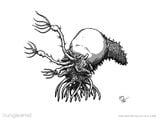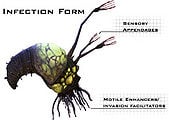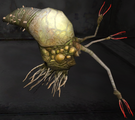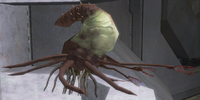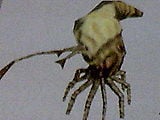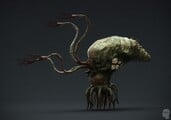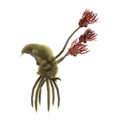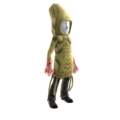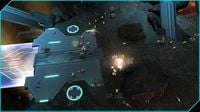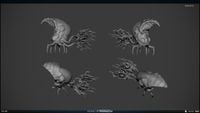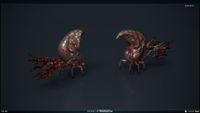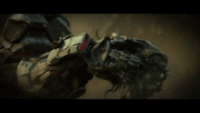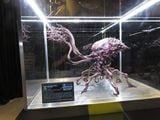User:JackVibe/Sandbox
From Halopedia, the Halo wiki
| This article does not meet the wiki's general standards and/or standards on layouts. You can help by cleaning this article. |
| This article does not have enough inline citations and/or does not adhere to the proper citation format. You can help Halopedia by adding citations. |
| Pod infector | |
|---|---|
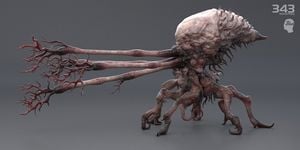
| |
| Biological overview | |
|
Classification: |
|
|
Species: |
|
| Physical information | |
|
Avg. height: |
89.6 centimeters (2 ft 11.3 in)-131.4 centimeters (4 ft 3.7 in)[1] |
|
Avg. weight: |
16.8 kilograms (37 lb)-28.6 kilograms (63 lb)[1] |
|
Distinctions: |
Small, sac-like creatures with many tentacles for probing. |
The pod infector,[2] often ubiquitously called the Flood infection form,[3][4] is a stage of the virulent Flood xenoform. It serves as the primary form for spreading the Flood infection due to its effectiveness compared to mere Flood spores when deployed in large numbers. Subsequently, it is usually the first Flood forms to be produced as well as the most commonly encountered Flood form.[2]
Overview
Physical characteristics
Pod infectors have soft, pod-shaped bodies; they are characterized by a small, sagging brown lobe rising from the top of its back,[3] while its frontal surface has numerous tentacle-like appendages and a frond-like array, which acts as the creature's sensory system.[5][4] Their tendrils are multi-purpose locomotion systems and insidious methods of control.[5][4] Used for attacking and infecting organisms,[6] each tendril ends in nano-scale barbs, which can latch onto a target's body, slice open bare skin,[7] and even cut through armor or environmental suits.[5][4] The pod infector's bulbous body is filled with noxious gases,[4] while its numerous tentacles allow them to travel at high rates of speed and leap surprising distances in pursuit of a host.[1]
The pod infector does not feel pain or fear.[8] Though barely intelligent on their own, once an infection form infiltrates a sentient creature, they turn the victim's cognitive power to the furtherance of Flood goals. Each pod infector able to sift through memories of any sentient creature to learn of military countermeasures, security access codes, and the location of population centers. This information is then shared with other Flood through their connection with the key minds.[5]
Function
Pod infectors develop from a form vaguely resembling a larva or tadpole but bearing the basic superficial characteristics of a Pod infector. A number of Flood forms in this stage of their life cycle were kept in stasis by the Forerunners in Flood research facilities, such as the one in the Threshold gas mine.[9]
Serving as the primary vector for the Flood infection, pod infectors usually attack en masse, overwhelming and overpowering their prey, until one is able to burrow into the victim's flesh,[1] As with other infection forms, the pod infector has an array of "penetrators", which are barbed tentacles that can cut through flesh and armor.[5][4] When a pod infector attacks a victim, its tentacles insert into the spine,[10] with the goal of invading the target's central nervous system,[11] which then initiates a violent transformation.[1] Once the target is compromised, the pod infector injects Flood cells to suborn the victim's nervous system while the pod infector itself bores into the host body to hollow out a nest, quickly twisting the remains of its victim into a combat or carrier form.[4]
Due to the balloon-like qualities of the pod infector, it could deflate itself to fit inside the victim's body.[12] Even if the infection form is quickly removed, Flood cells in the wounds will slowly consume the victim and turn them into quivering, spore-packed blisters. Against unprepared victims the infection form bores into the body, quickly mutating it into a combat form.[5] If the infected host has sufficient biomass for self-sustenance, it will mutate neurologically and physiologically into a combat form.[13] The pod infector is capable of augmenting its new body and repair minor damage;[8] as such, combat forms typically possess unnatural physical strength, perhaps gained through the mutation of the host's musculoskeletal structures.[13] Otherwise, sections of the host's body are consumed and converted into FSC, with much of their internal organs being consumed and replaced with FSC accretions that function as support lattices. Some limbs and sensory organs are retained on the combat form to enable use of tools, weapons, or vehicles; though the pod infector sees the environment using its own sensory organs—often the flexible fronds or antennae on the end of narrow tendrils—and whatever remains of the host's native senses are usually redundant and ignored.[8] In some circumstance, the pod infector is unable to completely dominate the original personality and the victim remains fully aware of their irrevocable transformation and their being used as a tool of the Flood. Though their bodies are bent to the Flood's will, occasionally the victim can still whisper for mercy or cry out in pain. More often, the parasite will speak on their behalf, using stolen thoughts and memories as a psychological weapon, terrorizing both the host and anyone unfortunate enough to be within earshot.[8][14] This was the fate of Wallace Jenkins during the Battle of Installation 04; a pod infector had been severely weakened during long periods of hibernation, and while strong enough to take over and transform Jenkins' body, it lacked the force and clarity to completely control Jenkins.[15] With the Flood mind weakened, Jenkins survived infection, and even remained conscious, with short periods of time where he could exert control over his mutated body.[16][17]
A Pod infector may abandon its host if the corpse has been heavily damaged, and look for a new one. If the Pod infector inside a combat form has been destroyed, but the combat form itself is intact enough to continue serving its purpose, loose Pod infector may burrow inside the body and take the place of the one that mutated it, effectively "re-animating" the combat form.
Once the parasite can establish a hive, it can begin to produce massive numbers of infection forms that spread out in search of new sentients to infect, and non-sapient animals on which to feed. Both ground and airborne infection forms are used as living weapons, hurling themselves at the enemy to overwhelm defenses and assimilate the unprepared.[4] The Flood blister itself is an infection form, incubating spores as well as carrying pod infectors; when ruptured, the blister releases the pod infectors.[18][19] Carrier forms serve as mobile incubators of pod infectors; when they are in close range of enemies, or when their sacs are perforated, they rapidly swell and then detonate,[13] releasing pod infectors being held within.[20] Flood pure forms, including the spawner form and the tank form, are known to gestate pod infectors to spread the Flood infection.[21][22]
Once this is accomplished, the form rewrites the neural pathways of the victim's brain with its tendrils, forcing a resonant frequency match between its neural signals and the host's.[citation needed] At this point, the Pod infector has complete control over the body's motor functions.
As the Pod infector hacks into the host's nervous system, it releases encapsulated Flood Super Cells into the body. These cells interface with the host's cells, "digest" them and convert their components into new Flood cells.[citation needed] At this point, the Pod infector burrows into the host body, moving aside the internal organs and taking up residence within the chest cavity (or any approximate equivalent). Having achieved total control over the host, the Pod infector reshapes the body into a form more suitable for attacking enemies - a combat form.
While an effective vector of infection against armored and shielded organisms as well as those equipped with atmospheric filters, a Pod infector is not necessary for the Flood to infect a host; merely ingesting Flood spores or inserting them via a wound is sufficient to initiate Flood conversion. Such infection may occur several seconds or perhaps minutes later, yet the transformation will occur almost instantaneously once it has begun.[23][24]
Effects on host forms
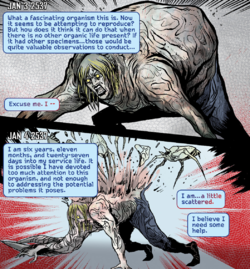
While any large life form with some level of awareness and/or sentience can be infected by a Pod infector, not all of them are suitable to serve the function of Combat Forms, the Flood's signature and preferred mobile form utilized during the Feral Stage. While these hosts are transformed in a similar fashion to the traditional combat forms, these forms are not often employed in front line combat for several reasons.
The first of these would be the fact that such life forms, despite their sophisticated nervous systems and adequate levels of sentience, simply lack the necessary biomass, calcium reserves, and physical strength to make first-choice combat units. More specifically, when a host life form is transformed, the activities of the Pod infector require not only the aforementioned levels of biomass, calcium content, and strength (Though humans become combat forms more often than the much larger and stronger unggoy for whatever reason.) but that the host has the physical endurance and stamina to withstand the process. Species such as humans, Forerunners, Sangheili, and the Jiralhanae are almost always turned into combat forms because their biology and physical properties enable them to withstand the Pod infectors' abilities, which are violent and resource-intensive.
In contrast, other life forms, such as the Kig-Yar, and perhaps the Yanme'e, lack these important qualities, or in the case of the Unggoy have other limitations due to their physique despite their perfectly adequate levels of sentience and neural complexity. Because of these factors, these hosts are primarily used for other but equally important purposes. These involve multiple mission profiles that are essential to the development of Flood outgrowth: establishment of mobile incubators, biomass and calcium reserves, hive structures, and the components of a coordinating and controlling intelligence.
When utilized for the creation of the hive and the central intelligence, the weaker hosts gather together and merge into single mass or a collection of masses spread around whatever environment the Flood have established themselves in. In this way, the weaker host forms serve as 'building blocks' for the creation of a Flood Hive, which if all goes according to its logical conclusion, will spawn a fully-developed collective and the next stage of the Flood's development: the Coordinated Stage and its crowning achievement, a Gravemind. Surrounding life forms such as significantly smaller animals as well as the full range of plants, microbes, lichens, and fungi, are seized by the growing Flood collective and digested as raw material to create more generic Flood biomass.
The next vital use for lesser hosts is to serve as the second signature form of the Feral Stage, the mobile Pod infector incubator known as a Carrier Form. While these are usually formed from weakened, damaged, and/or aged Combat Forms, weaker host forms are just as frequently employed for this purpose. The first step in the creation of a Carrier Form by this method involves a single appropriate host to function as a nucleus, which is then followed by one or more other weaker forms attaching themselves to the leading unit. The congregated hosts then fuse, with the external host forms being rapidly digested by the central form, with the result being that the other hosts have been reduced to extra, generic biomass, contributing to the structure of the now significantly distorted, bloated incubator.[25]
While this complex methodology is largely standard procedure for the Flood, there are occasionally exceptions to these rules due to the Flood's adaptive nature. In at least one notable campaign[26] early in the Human-Covenant War, this mode of operation was contradicted by the Flood. The outbreak present on this installation employed Kig-Yar and Unggoy quite frequently as front line combat units despite their inadequate status, and was also distinct from other outbreaks with the fact that it was predominantly formed out of life forms lacking sentience such as plants, fungi, etc., or those possessing lower levels of sentience, such as the wide range of animals living there.
Immunities and defenses
Energy shielding destroys Pod infectors on contact, causing them to explode in a small burst of gas and flesh. Conventional body armor is generally ineffective against Pod infectors; they can easily squeeze through gaps in armor plating, and their grasping tentacles can burrow through rubber, fabric or polymer (including MJLONIR MK V undersuits) in order to reach the flesh underneath.
Staff Sergeant Avery Johnson was thought by Dr. Catherine Halsey to be incompatible with Flood Pod infectors due to the fictitious "Boren's Syndrome"[27] — in reality a cover for the augmentations he received as part of the ORION Project.[28] However, it is apparent that Johnson's augmentations did not make him truly immune to the Flood conversion process itself, instead granting him the ability to fight off and escape the parasite more effectively than the baseline humans alongside him.[29][30][31]
The Mgalekgolo's lack of a central nervous system and nature as an invertebrate colony consisting of multiple worms likely make them immune to Flood infection.[32] The invertebrate nature of the Yanme'e, along with their hard, chitinous exoskeleton, would seem to make them immune as well. However, while their unique physiologies make standard infection difficult, it is likely that the Flood are still capable of consuming and converting Lekgolo and Yanme'e into Flood biomass.
Trivia

|
See our gameplay information related to JackVibe/Sandbox on its gameplay page. |
- In Halo: Combat Evolved, if a Pod infector latches itself onto a Marine or one of the Covenant, instead of mutating the host, it will become irrevocably attached until the host is dead. If at least one Pod infector manages to leap onto an unshielded player in this game, it will deal a noticeable amount of damage (this will increase depending on difficulty and number of Pod infectors attached), fall off, and attempt to strike the player again. This effect on the player also appears in Halo 3.
- An energy sword will not lose energy by killing Pod infectors in Halo 2 and Halo 3, but this method is highly ineffective as Pod infectors are extremely hard to hit with an Energy Sword.
- Pod infectors do not add points to the player's meta-score when the campaign scoring is activated in Halo 3 and Halo: The Master Chief Collection. This is most likely because Pod infectors come in swarms, and could be used to rack up points with almost no effort.
- Unlike in Halo: Combat Evolved and Halo 2, the Pod infectors in Halo 3 float in water. Thus, they cannot infect corpses that are in water ponds because of this animation.
- In Halo Wars, when Sergeant Forge shoots the Flood Pod infectors that are attacking Professor Anders, they do not pop like all other Pod infectors. Instead, they simply fall lifelessly to the ground.
- In Halo 3, code exists for a deleted "banger" variant of Pod infector, which would explode like a plasma grenade when destroyed.[33]
- In Halo: Combat Evolved, Pod infectors are not affected by fall damage, most likely due to the script or slow speed during freefall.
Gallery
Flood Pod infector in Halo: Combat Evolved.
A Pod infector in the Threshold gas mine in Halo 2.
Render of the Halo 2 Pod infector in Halo: The Master Chief Collection.
Pod infectors in Halo 3.
A Pod infector in Halo Wars.
Pod infectors assaulting Professor Anders.
An Xbox 360 Avatar customized with a Flood Pod infector suit.
A Flood Pod infector inside the UNSC Spirit of Fire's cryo-room in Halo: Escalation.
Flood Pod infectors in Halo: Spartan Assault.
Jerome-092 destroying a Pod infector in a single punch in Something has Happened.
Models of the Pod infector for Halo Wars 2.
An infection form at Outpost Discovery.
A Pod infector trapped in a Cylix on Installation 07 in Halo Infinite.
List of appearances
|
Sources
- ^ a b c d e Halo: Combat Evolved Anniversary, Library: Infection Form
- ^ a b Halo Wars 2, Phoenix Logs: Pod Infectors
- ^ a b Halo Encyclopedia (2011 edition), page 164
- ^ a b c d e f g h Halo Encyclopedia (2022 edition), page 406
- ^ a b c d e f Halo Wars 2, Phoenix Logs: Infection Forms
- ^ Halo Encyclopedia (2011 edition), page 180
- ^ Halo: The Flood, chapter 12: "The Spartan gave a cry of pain, felt the tentacle slide down toward his spine, and knew it was over."
- ^ a b c d Halo Encyclopedia (2022 edition), page 408
- ^ Bungie.net: One Final Effort (4/16/2010)
- ^ Halo: The Flood, chapter 9: "...because ever since the infection form had inserted its penetrator into his spine, Private Wallace A. Jenkins had been sharing his physical form with something he thought of as "the other.""
- ^ Halo: The Flood, chapter 10: "...it has tentacles in place of legs, plus a couple of extremely sharp penetrators, which they use to invade the victim's central nervous system and take control of it."
- ^ Halo: The Flood, chapter 10: "If you peek through the hole in her chest you can see the remains of the infection form that deflated itself enough to fit in around her heart and lungs."
- ^ a b c Halo Encyclopedia (2011 edition), page 165
- ^ Halo Wars 2, Phoenix Logs: Infected
- ^ Halo: The Flood, chapter 6: "Due to some fluke, some random toss of the galactic dice, the mind that invaded his body had been severely weakened during the long period of hibernation, and while strong enough to take over and begin the work necessary to create a combat form, it lacked the force and clarity required to completely dominate its host the way it was supposed to."
- ^ Halo: The Flood, chapter 10: "Jenkins had used pantomime to request a mirror. A well-meaning Corporal brought one in, held it up in front of the soldier's devastated face, and was frightened when he tried to scream."
- ^ Halo: The Flood, chapter 12: "Jenkins, still unable to speak, managed to mouth the words “thank you.”"
- ^ Halo 3, campaign level Cortana
- ^ Halo Encyclopedia (2022 edition), page 407
- ^ Halo Encyclopedia (2022 edition), page 409
- ^ Halo Encyclopedia (2011 edition), page 166
- ^ Halo Wars 2, Phoenix Logs: Spawners
- ^ Halo Wars, campaign level Anders' Signal
- ^ Halo: Evolutions — "The Mona Lisa"
- ^ 'Halo: The Flood', page 291
- ^ Halo Wars
- ^ Halo: First Strike, page 244
- ^ Halo Graphic Novel, page 122
- ^ Halo Waypoint: Catalog Interaction - Page 14 ("No known biological [scaffolding] augmentation impedes efficacy of parasite conversion process.")
- ^ Halo Graphic Novel, Breaking Quarantine
- ^ See Avery Johnson#Notes
- ^ Halo: First Strike
- ^ YouTube: Halo 3 - Cut Enemy: Flood Infection "Banger"
| |||||||||||||||||||||||||||||||||
